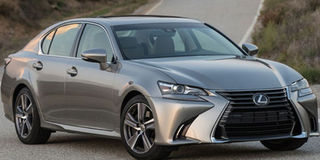Lexus GS: Perfect car for the executive

What you need to know:
Compared to the Lexus ES, which was new for 2019, the GS is a little more raw, with rear-wheel-drive bias, and a high-performance variant.
The third generation 2006-2012 GS was the first Lexus to be styled according to the brand’s then-new “L-Finesse” design language. It was the company marketing department’s way of saying that all future Lexus cars would bear some resemblance to this car. It was the third generation of Lexus’ (Toyota’s upscale brand, for anyone not already aware of the connection) mid-range sedan, which slots in between the entry-level IS and ES, and the big LS super-luxury sedan.
One of the nice things about a second-hand Lexus GS is that it will probably have had only private owners in the past, and will have been looked after like any other expensive high end car in private hands.
So most of them found homes with caring, conservative owners who were looking for a reliable, luxury experience, but who did not want the default-setting European cars on offer at the same time, which is precisely the buying proposition that exists for a second-hand GS.
Exterior
The GS has always been the looker with the first generation having Italian design heritage. This looks nicer. Along with 18-inch rims, this car is meant to look sporty yet easy on the eyes. It seems the designers were going for simplicity yet sculpted. In the used car market, you shall get this in a host of colours but looks most inviting in silver. But that is just me. The quad front headlamps are an evolutionary carry over from the previous generation and still look good. The rear is a bit of a mixed bag, although it grows on you.
Interior
The Lexus GS is very well appointed. Open the door and you are greeted by typical Lexus luxury. The brand has made a quality audio system, a key component of its brand identity, so it is no surprise that the GS sedan has a premium system outputting tunes through a 10-speaker sound system.
While the interior is beautifully made and offered great front seats and a multi-adjustable driving position, the GS’ real flaw was the rear seat. It is simply too tight for big people and has an almost comical lack of headroom thanks to that sloping roofline. Everything else is perfect from the controls to the steering.
Driving dynamics
The Lexus is known for a smooth ride and luxury appointments, and the GS has accomplished road manners. Its fundamental sense of balance makes driving enjoyable. Even during a morning commute, you can seize a few moments of driving enjoyment. The previous-generation GS 300’s 3.0-litre, in-line six-cylinder engine was replaced with a new, direct fuel-injected V6 of the same displacement that made 245 horsepower, increases of 20 hp over the old engine.
The GS 400 was replaced with the GS 430, named for its larger, 4.3-litre V8 engine, which was good for 300 hp. Both engines were matched with a six-speed automatic transmission (the only one offered). This car was also Lexus’ first all-wheel drive model, although it was available only with the V6 engine.
While the V6 is more than capable and quite a sweet engine into the bargain, the V8 is the killer punch for keener drivers, with smooth power and lots of it. The gear changes of both the six-speed automatic transmission are virtually undetectable. The GS is not the sort of car that encourages manual shifting, but it is a performance car, and the feeling of acceleration is a large part of its appeal.
Value
Historically speaking, the GS has sometimes been the forgotten Lexus. Unlike the German luxury mid-sizers it goes up against, the GS just never really gained showroom traction. But this is brilliant news for those after a second-hand Lexus GS, because it means they’re not on the radar of some buyers. That makes them cheaper than they might otherwise have been.
Given the Lexus brand’s stellar performance in most customer satisfaction surveys globally, it is no surprise to find that GS cars are pretty reliable and that Lexus luxury treatment and Toyota reliability, should raise the value bar for this car. If you can get over the fact that your street cred will not be as hulking as with the German competition, then you have value for money at just over Shs40m for the cheapest example.
Competitors
Mercedes-Benz E-Class: This is more or less the default setting in this market segment and a favourite introduction for many to the brand in Uganda.
BMW 5-Series: BMW’s styling theme at the time just didn’t work for many buyers, but it is still a great drive. Lack of a local authorised BMW dealer is discouraging as BMWs are known to be problematic in old age.
Audi A6: As with the GS, the A6 has historically been a bit overlooked. Fabulous interior with huge attention to detail and a quality feel.




